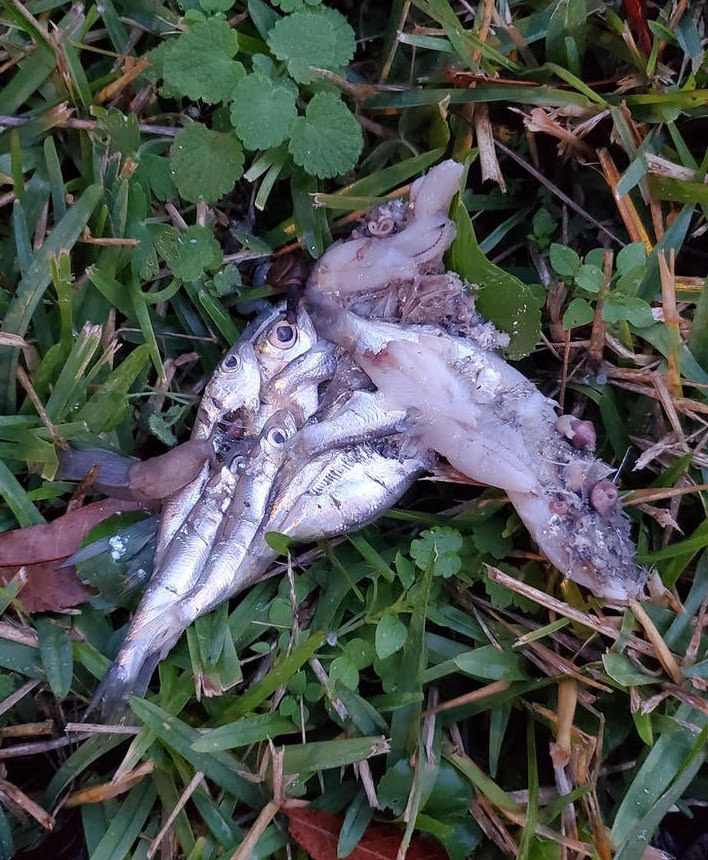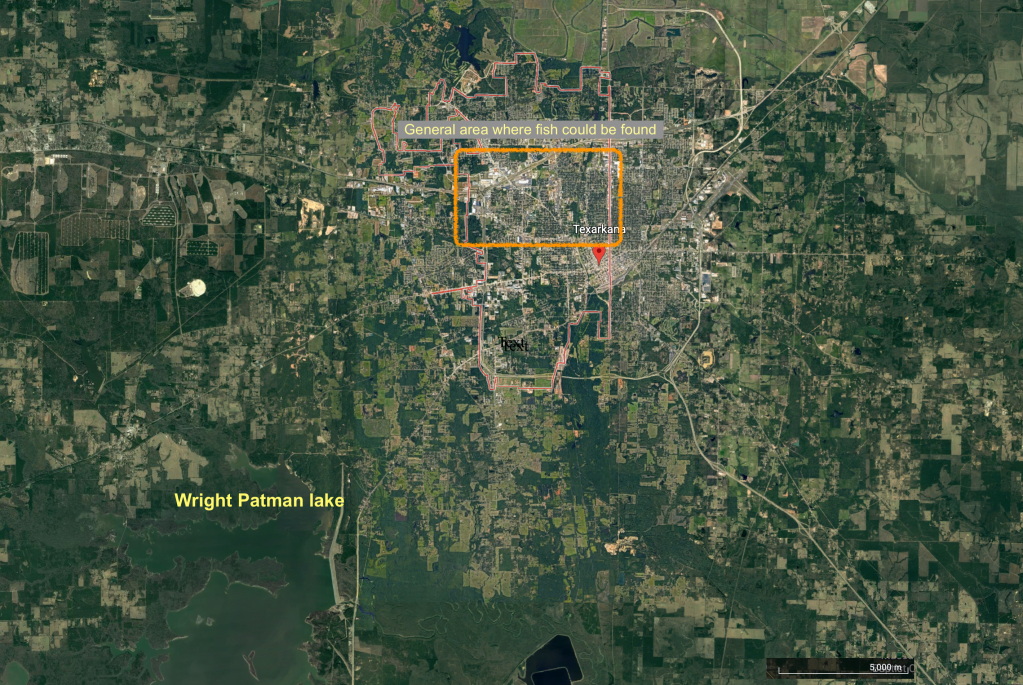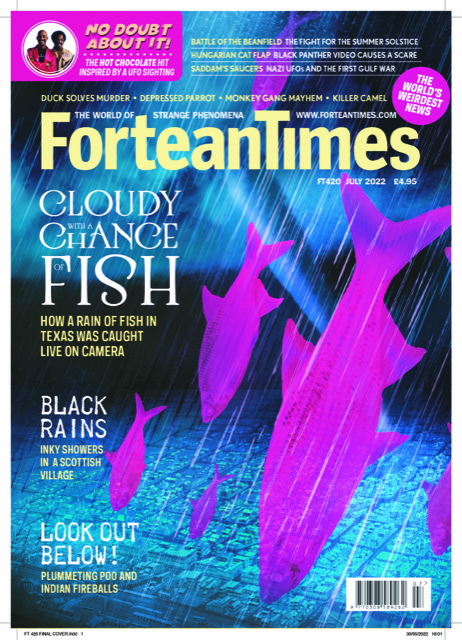I am excited to share the results of an investigation done by Paul Cropper and myself on the strange fish rain in Texarkana on 29 December 2021. The results have been published in the July 2022 issue of Fortean Times (FT420).
We are fairly confident we determined the factors that led to fish falling across this area of Texas: A flock of cormorants (and possibly other birds) disgorged their recently consumed meals of small shad while in the air or perhaps during takeoff.

Paul secured a video, probably the first ever, that shows fish falling as it happened. It’s a huge Fortean milestone, I think. And I hope it tamps down the probably bogus idea that fish (or other animals) are swept up in waterspouts and deposited over towns. There is actually no evidence for that happening.
Press Release
Texarkana fish rain had unexpected and unpleasant source
The fish that fell in a December thunderstorm likely came from the nervous stomachs of birds that ejected their recent meal, investigators conclude.
An intense thunderstorm on December 29, 2021 brought dozens, if not hundreds, of small fish falling with the rain and hail over a four-mile swath of Texarkana. Paul Cropper, an Australian researcher of anomalous phenomenon, collected evidence that led him and colleague Sharon A. Hill (U.S.) to the unsavory origin of the fish rain – regurgitated bird stomach contents. Their conclusions are published in the July 2022 issue of Fortean Times magazine.
Cropper collected firsthand accounts from business employees, airport staff, and residents across town who found the fish strewn across the landscape. The two investigators also obtained assistance from scientists at the University of Texas Biodiversity Center in Austin. The fish, identified as Gizzard shad, had characteristics indicative of partial digestion. The researchers strongly suspect the fish had been eaten by cormorants (a common, large shore bird). Then shortly after, the birds, at least some of which were airborne, were caught up in the storm front and disgorged their meals.
Texarkana Regional Airport officials and a resident had noted the presence of cormorants around the time of the storm. Cormorants are common in large numbers and are known to exhibit the disturbing habit of expelling their stomach contents. The reason for this behavior is unknown.
Rains of fish have been reported for centuries, but direct evidence showing fish definitively falling from the sky was lacking, until now. Cropper collected photos and videos from locals who found the fish on streets, sidewalks, grass, parking lots and the airport runway. More importantly, fish remains were found in truck beds and on roofs – indicating that they fell from some height. He obtained high resolution security footage from Discount Wheel & Tire on Summerhill Road that appears to show six fish impacting the ground during the storm. Employees collected many dead fish from their parking lot after the rain. This footage appears to be the first video documentation of fish falling from the sky during a rain event. (https://www.youtube.com/watch?v=rnE_a_WfgAU “Texas Rain Of Fish December 2021”)
While many media outlets reported that the fish were sucked up by a waterspout and dropped some distance away, this hypothesis has never been documented and does not fit the evidence in Texarkana. Additionally, Cropper and Hill confirmed no waterspout occurred during this storm and no other human-related distribution of fish via aircraft or by hand was plausible. The bird theory remains the best fit for the evidence. Samples of the fish were retained by the University staff for further testing.
How the investigation transpired
On December 30 of 2021, Paul Cropper messaged me about a rain of fish that had just been reported in Texarkana (Texas and Arkansas) from the previous afternoon. The local TV news reported on the event which appeared to show a considerable number of fish. Shortly after, it was clear that fish fell across a considerable area. Then, photos appeared showing the fish in the beds of pickup trucks and on rooftops. This was the crucial observation! Many reports of fish falls are not really “falls” but the result of flooding streams or a human-related event. The immediate release of multiple reports and photos of fish that really did appear to fall indicated this was an investigation worth pursuing.



Paul quickly contacted the media reporters, the local businesses, and also solicited reports on Facebook. And he got great responses. Eventually, he collected many photos and some videos. He talked directly to people who witnessed the event, and then contacted scientists at the University of Texas in Austin.
For the next few weeks, we looked at the evidence and had email discussions with many involved. We had some working hypotheses to consider as the additional information came in. Initially, the most reasonable hypotheses were as follows:
1. Storm related flooding and wind – the fish appeared in unusual places because of creek flooding or they moved over land due to the heavy rain. Or, that they were blown out of a shallow pond.
2. Dropped from a plane – the fish were dumped, possibly from a plane that was seeding a lake.
3. Waterspout – the default idea that fish are sucked up from a water source and dumped miles away.
4. Birds – the fish had been dropped by birds that were carrying them in their beaks, talons, or stomachs.

Unfortunately, we couldn’t get to Texarkana, but thanks to Google Earth we were able to map the nearest water sources. While there were small streams and a few ponds nearby, these sources couldn’t account for the distribution of fish across the town and in residential and business areas. The fish were not coming out of the storm sewers, they were falling. We had ample evidence for that. The fish were not of the type that “walk” across land during rains.
Fish are sometimes dumped into stocked lakes via plane. But this is not that common. This explanation would have likely been reported by the agency doing the stocking. The most obvious reason this was discarded was because planes weren’t flying under these weather conditions and the closest lake, Wright Patman, was 8 miles away.
We determined from weather data that the storm front did pass over Wright Patman lake, which had this species of fish, but the tracking was more north-northeast and not a direct line. Although there was hail, no tornadoes were reported. Further information from National Weather Service personnel confirmed that no unusual conditions were seen at the lake for this storm event. The waterspout idea could be confidently ruled out.

We did have evidence of birds flocking in the area. A local resident filmed a disoriented large bird (likely a cormorant) in her neighborhood at the end of the storm.
The regional airport personnel noted that flocks of cormorants are common and some had been seen prior to the storm. We were also well aware of the habit of these fish-eating birds to release their stomach contents either to quickly fly away or to feed their young. This was a known and common behavior that had been observed by bird researchers. But they had never seen it happen during active flight (we asked them). Therefore, this remains a weakness of the hypothesis.
Fortuitously during this time, I found a news video out of Holland documenting the annoyance of townspeople next to a canal where cormorants vomit their food on the walkways.
You have to see cormorants eating fish to understand why the fish in the fall looked relatively whole and why there were so many.
The University researchers managed to pick some frozen fish samples from the local resident who was cooperating with the investigation. They corresponded with us noting that the fish samples did appear to be in various stages of decomposition consistent with digestion (head first). They still currently have the samples and are attempting to test them for bird DNA. We hope to hear the results soon.
Conclusion
We felt confident we know where the fish came from. But the extent and number of fish was still a little shocking. Not everyone will accept the conclusion. Some skeptics might continue to deny the fish fell at all. But we’re very confident that they did. There were many independent witness, reporting at the same time, with photographic evidence over a wide area, including documenting locations off the ground and in private or publicly inaccessible areas (such as the airport runway) that confirm that this was indeed a fish rain. But the most impressive evidence we hoped for was a video.
Thanks to Paul’s diligent work and the generous cooperation of contacting Discount Wheel and Tire, the business on Summerhill Road featured in the news reports, we’ve got a video.
Granted, it’s not crystal clear that all the objects seen falling were fish. At least one could be wind-blown debris. We must consider that the employees collected a bucket full of dead fish in this exact area after the storm and witnessed the fish falling as well. It’s not reasonable to discount or dismiss this video evidence – it supports the fact that the fish did fall from the sky that day, exactly as described by witnesses.
It’s also not reasonable to discount the conclusion we’ve made here. We know this behavior happens in birds. The surprising aspect is the extent of the fall. This scenario hasn’t been this well-documented before. Also surprising is the attention this event received worldwide. It’s my hope that the conclusions made in this investigation also become known worldwide. We’ve learned something highly interesting (though a bit yucky) about the natural world.
Thanks to Fortean Times for being the platform for this investigation report. We are the cover story! SUBSCRIBE!

Additional sources
“Hail, Fish, & Videotape: A Texas Fish Rain Caught on Camera”, Fortean Times, No. 420, July 2022. PDF download here.
“Like Ducks and Penguins, With Nervous Stomachs”, New York Times, 22 Aug 2007. http://www.nytimes. com/2007/08/22/nyregion/22birds.html
“Residents of East Texas town report fish falling from sky”, Dallas Morning News, 2 Jan 2022. http://www.dallasnews.com/news/texas/2022/01/02/residents-of-east-texas-town-report-fish-falling-from-sky/
“Storm rains bushels of fish on Texarkana”, Texarkana Gazette, 29 Dec 2021. http://www.texarkanagazette.com/ news/2021/dec/29/fish-appear-in-several-places-in-texarkana-after/
“A Fishy Day: Fish fall from the sky in Texarkana”, KSLA News 12, 30 Dec 2021. http://www.ksla.com/2021/12/30/ fishy-day-fish-fall-sky-texarkana/
“Fish rain from sky in Texarkana”, KTAL News, 29 Dec 2021. http://www.arklatexhomepage.com/news/local-news/ fish-rain-from-sky-in-texarkana/
“It’s Raining Fish! The Ichthyology Collection Now Holds Rare Fish Rain Specimens.” University of Texas Biodiversity Blog: biodiversity.utexas.edu/news/entry/ ichthyology-collection-now-holds-fish-rain-specimens
Citing this blog: Hill, Sharon A. (2022) “Texarkana Fish Rain Mystery Solved”. SharonAHill.com, 18 June 2022.
Contact
Please contact me at Lithospherica@gmail.com for additional information and interview requests. Contact Paul via https://www.thefortean.com/.

2 responses to “Texarkana Fish Rain Mystery Solved”
I live in Trinity,Tx.I clean houses and do yard work was a few years ago and the lady i was working for lives on lake she has a couple of acresanyway i was raking the yard at the fornt of the proprrty and all of a sudden a fish fell out of the sky i couldnt beleive everyone thought i was crazy.
There have been many times when a single fish has fallen out of the sky and even hit a person! These seem to be cases of birds dropping fish they were carrying in talons or their mouths. It’s not crazy, it’s just physics and the occasional bird whoopsie.